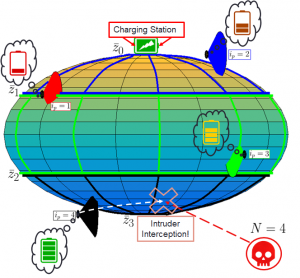Presented By: Aerospace Engineering
Defense Dissertation: Dynamic Coverage Control and Estimation in Collaborative Networks of Human-Aerial/Space Co-Robots
William M. Bentz

William M. Bentz
Committee:
Assistant Professor Dimitra Panagou (Chair)
Professor Ella M. Atkins (Member)
Professor Ilya V. Kolmanovsky (Member)
Assistant Professor Ram Vasudevan (Cognate Member)
Presentation Info:
March 18, 2020
10:00 AM
1044 FXB (McDivitt Conference Room)
The past twenty years have seen rapid improvements in the performance of small unmanned aerial vehicles as well as the continued miniaturization of low-cost sensors. The intersection of these technologies has given rise to a renaissance of control and decision-making developments geared towards mobile wireless sensor networks (MWSNs). One such development, dynamic coverage control, enables MWSNs to rapidly explore and gather information from uncertain environments. This defense will overview contributions to dynamic coverage in environments containing information decay, stochastic intruders, and power-constrained vehicles.
The extension of coverage to collaborative networks of humans and aerial/space robots shall also be presented. The author considers a human wearing an augmented reality (AR) device while completing multiple interdependent tasks that are time-sensitive and spatially separated. The problem of coverage is here coupled to that of human intent inference. An aerial robot shares the environment and uses machine learning in order to determine both the locations of tasks as well as their temporal context. This enables the streaming of real time task images that are beyond the human’s field of view to their AR display. In such a way, the human can instantaneously cover a greater volume of the environment than is naturally possible.
Committee:
Assistant Professor Dimitra Panagou (Chair)
Professor Ella M. Atkins (Member)
Professor Ilya V. Kolmanovsky (Member)
Assistant Professor Ram Vasudevan (Cognate Member)
Presentation Info:
March 18, 2020
10:00 AM
1044 FXB (McDivitt Conference Room)
The past twenty years have seen rapid improvements in the performance of small unmanned aerial vehicles as well as the continued miniaturization of low-cost sensors. The intersection of these technologies has given rise to a renaissance of control and decision-making developments geared towards mobile wireless sensor networks (MWSNs). One such development, dynamic coverage control, enables MWSNs to rapidly explore and gather information from uncertain environments. This defense will overview contributions to dynamic coverage in environments containing information decay, stochastic intruders, and power-constrained vehicles.
The extension of coverage to collaborative networks of humans and aerial/space robots shall also be presented. The author considers a human wearing an augmented reality (AR) device while completing multiple interdependent tasks that are time-sensitive and spatially separated. The problem of coverage is here coupled to that of human intent inference. An aerial robot shares the environment and uses machine learning in order to determine both the locations of tasks as well as their temporal context. This enables the streaming of real time task images that are beyond the human’s field of view to their AR display. In such a way, the human can instantaneously cover a greater volume of the environment than is naturally possible.